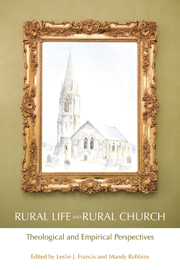Book contents
- Frontmatter
- Contents
- Preface
- Foreword by The Bishop of Shrewsbury, The Rt Revd Mark Rylands
- 1 Introduction: shaping rural theology
- PART 1 PERSPECTIVES FROM THE BIBLE
- 2 Israelite wisdom and pastoral theology in the rural church
- 3 The invisible countryside of the New Testament
- 4 Sheep and goats: pastoral imagery in the Bible and today
- PART 2 PERSPECTIVES FROM ORDINARY THEOLOGY
- PART 3 THEOLOGICAL AND SOCIOLOGICAL PERSPECTIVES
- PART 4 HISTORICAL PERSPECTIVES
- PART 5 LISTENING TO VISITORS
- PART 6 LISTENING TO THE COMMUNITY
- PART 7 LISTENING TO CHURCHGOERS
- PART 8 LISTENING TO CHURCH LEADERS
- PART 9 SATISFACTION AND STRESS IN MINISTRY
- Contributors
- Sources
- Subject Index
- Name Index
4 - Sheep and goats: pastoral imagery in the Bible and today
from PART 1 - PERSPECTIVES FROM THE BIBLE
- Frontmatter
- Contents
- Preface
- Foreword by The Bishop of Shrewsbury, The Rt Revd Mark Rylands
- 1 Introduction: shaping rural theology
- PART 1 PERSPECTIVES FROM THE BIBLE
- 2 Israelite wisdom and pastoral theology in the rural church
- 3 The invisible countryside of the New Testament
- 4 Sheep and goats: pastoral imagery in the Bible and today
- PART 2 PERSPECTIVES FROM ORDINARY THEOLOGY
- PART 3 THEOLOGICAL AND SOCIOLOGICAL PERSPECTIVES
- PART 4 HISTORICAL PERSPECTIVES
- PART 5 LISTENING TO VISITORS
- PART 6 LISTENING TO THE COMMUNITY
- PART 7 LISTENING TO CHURCHGOERS
- PART 8 LISTENING TO CHURCH LEADERS
- PART 9 SATISFACTION AND STRESS IN MINISTRY
- Contributors
- Sources
- Subject Index
- Name Index
Summary
Abstract – The Bible makes frequent use of the imagery of sheep and shepherds, both to illustrate God's care for his people and also in relation to human leaders of the nation (Old Testament) and the Church (New Testament). This article suggests some ways in which an informed awareness of the reality of a shepherd's life may enrich our understanding of such imagery. It also draws attention to some limitations of the metaphor, and warns against sentimental misconceptions of the ‘pastoral’ role.
Introduction
The Anglican ordination service describes the work of a priest as that of a ‘servant and shepherd’, who is to ‘keep the Good Shepherd always before you as the pattern of your calling’. I expect other churches use similar words – after all, ‘pastor’ is one of the commonest terms across the denominations to describe a Christian minister.
I wonder how much that imagery means to many in our urbanized western culture. Most people know that shepherds are people who wear tea-towels on their heads at Christmas and blow their nails when icicles hang by the wall, but how many have met a real shepherd, let alone understand what the shepherd's work involves?
So we country folk have an advantage. Here among the hills of Meirionnydd, one member of my ministry training group is a shepherd's wife and two others keep a few sheep, while a former member is now priest-in-charge of the same parishes where he was until recently a full-time shepherd. Such real-life links give added depth to the pastoral imagery.
- Type
- Chapter
- Information
- Rural Life and Rural ChurchTheological and Empirical Perspectives, pp. 33 - 40Publisher: Acumen PublishingPrint publication year: 2012



